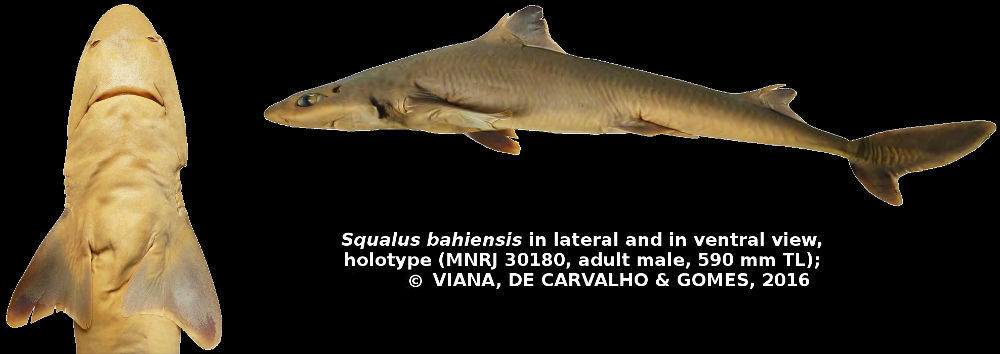Squalus bahiensis
Viana, De Carvalho & Gomes, 2016
Classification: Elasmobranchii Squaliformes Squalidae
Reference of the original description
Taxonomy and morphology of species of the genus Squalus Linnaeus, 1758 from the Southwestern Atlantic Ocean (Chondrichthyes: Squaliformes: Squalidae). Zootaxa, 4133(1), 1–89
Taxonomy and morphology of species of the genus Squalus Linnaeus, 1758 from the Southwestern Atlantic Ocean (Chondrichthyes: Squaliformes: Squalidae). Zootaxa, 4133(1), 1–89
Description :
Citation: Squalus bahiensis Viana, De Carvalho & Gomes, 2016: In: Database of modern sharks, rays and chimaeras, www.shark-references.com, World Wide Web electronic publication, Version 04/2024
Please send your images of "Squalus bahiensis" to info@shark-references.com

Squalus bahiensis in lateral and in ventral view, holotype (MNRJ 30180, adult male, 590 mm TL); © Viana, De Carvalho & GOMES, 2016

Squalus bahiensis in lateral and in ventral view, holotype (MNRJ 30180, adult male, 590 mm TL); © Viana, De Carvalho & GOMES, 2016
Common names
 Northeastern Brazilian dogfish,
Northeastern Brazilian dogfish,  Cação-bagre-da-Bahia
Cação-bagre-da-Bahia
 Northeastern Brazilian dogfish,
Northeastern Brazilian dogfish,  Cação-bagre-da-Bahia
Cação-bagre-da-Bahia
Short Description
Original diagnosis after DE F. VIANA, DE CARVALHO & GOMES, 2016 [24274]: Squalus bahiensis sp. nov. is distinct from all species of the S. megalops group by having pectoral fins with free rear tips rounded (vs. free rear tips pointed), snout blunt and elongate (vs. snout rounded and short), and dermal denticles tricuspid and rhomboid (vs. dermal denticles unicuspid and lanceolate). Squalus bahiensis sp. nov. is distinct from S. mitsukurii by having a narrower interorbital space (8.2%, 7.9%–8.3% TL vs. 9.3%, 9.1%–9.8% TL in S. mitsukurii), and shorter lower caudal fin lobe (preventral caudal margin 11.4%, 10.9%–11.3% TL vs. 12.1%, 11.5%–12.4% TL). Squalus bahiensis sp. nov. can be easily distinguished from S. blainvillei from the Mediterranean Sea by having lower dorsal fins (first dorsal-fin height 6.9%, 7.0%–7.1% TL vs. 8.2%, 7.3%–8.7% TL in S. blainvillei; second dorsal-fin height 5.3%, 4.2%–4.4% TL vs. 7.2%, 6.6%–7.5% TL in S. blainvillei), and a shorter upper labial furrow (its length 2.3%, 2.2% TL vs. 2.5%, 2.4%–2.7% TL in S. blainvillei). Squalusbahiensis sp. nov. is distinct from S. lobularis by: caudal fin somewhat slender vs. upper caudal lobe rectangular in S. lobularis; second dorsal-fin spine not reaching dorsal-fin apex vs. reaching dorsal-fin apex in S. lobularis; shorter pectoral-fin inner margin (its length 8.1%, 8.4%–8.9% TL vs. 10.5%, 9.2%–11.0% TL in S. lobularis); and clasper outer length greater (5.0%, 4.6%–5.1% TL vs. 4.3% TL in S. lobularis).
Original diagnosis after DE F. VIANA, DE CARVALHO & GOMES, 2016 [24274]: Squalus bahiensis sp. nov. is distinct from all species of the S. megalops group by having pectoral fins with free rear tips rounded (vs. free rear tips pointed), snout blunt and elongate (vs. snout rounded and short), and dermal denticles tricuspid and rhomboid (vs. dermal denticles unicuspid and lanceolate). Squalus bahiensis sp. nov. is distinct from S. mitsukurii by having a narrower interorbital space (8.2%, 7.9%–8.3% TL vs. 9.3%, 9.1%–9.8% TL in S. mitsukurii), and shorter lower caudal fin lobe (preventral caudal margin 11.4%, 10.9%–11.3% TL vs. 12.1%, 11.5%–12.4% TL). Squalus bahiensis sp. nov. can be easily distinguished from S. blainvillei from the Mediterranean Sea by having lower dorsal fins (first dorsal-fin height 6.9%, 7.0%–7.1% TL vs. 8.2%, 7.3%–8.7% TL in S. blainvillei; second dorsal-fin height 5.3%, 4.2%–4.4% TL vs. 7.2%, 6.6%–7.5% TL in S. blainvillei), and a shorter upper labial furrow (its length 2.3%, 2.2% TL vs. 2.5%, 2.4%–2.7% TL in S. blainvillei). Squalusbahiensis sp. nov. is distinct from S. lobularis by: caudal fin somewhat slender vs. upper caudal lobe rectangular in S. lobularis; second dorsal-fin spine not reaching dorsal-fin apex vs. reaching dorsal-fin apex in S. lobularis; shorter pectoral-fin inner margin (its length 8.1%, 8.4%–8.9% TL vs. 10.5%, 9.2%–11.0% TL in S. lobularis); and clasper outer length greater (5.0%, 4.6%–5.1% TL vs. 4.3% TL in S. lobularis).
Dentition
Teeth unicuspid, similar in both jaws, broad and compressed labial-lingually at crown, imbricate laterally; upper teeth smaller and narrower than lower teeth; cusp small and heavy, markedly oblique and upturned, directed laterally; mesial cutting edge conspicuously convex; mesial heel notched; distal heel strongly rounded; apron thick; two series of functional teeth on upper jaws of holotype and three series in paratypes; two series of functional teeth in lower jaws; tooth rows varying from 13–14 (13–14 paratypes) in upper jaw and 11–12 (11–11 paratypes) in lower jaw [24274]
Teeth unicuspid, similar in both jaws, broad and compressed labial-lingually at crown, imbricate laterally; upper teeth smaller and narrower than lower teeth; cusp small and heavy, markedly oblique and upturned, directed laterally; mesial cutting edge conspicuously convex; mesial heel notched; distal heel strongly rounded; apron thick; two series of functional teeth on upper jaws of holotype and three series in paratypes; two series of functional teeth in lower jaws; tooth rows varying from 13–14 (13–14 paratypes) in upper jaw and 11–12 (11–11 paratypes) in lower jaw [24274]
Remarks
shark-references Species-ID=14608;
shark-references Species-ID=14608;
















